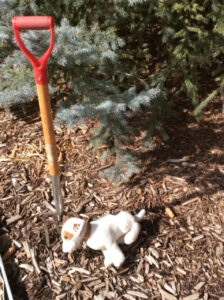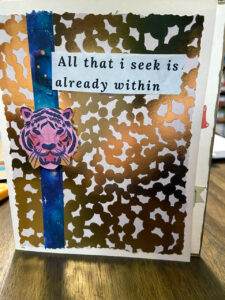We asked the CC faculty what got them through COVID. Was it nesting with Netflix? Huddling with Hulu? Did they hold quarantined concerts? Were they burgeoning bakers? It turns out, CC faculty members used the past year and a half in ways they might not have otherwise.
Fostering Kittens
Associate Professor and Chair of the Chemistry and Biochemistry Department Habiba Vaghoo fostered kittens with Happy Cats Haven. “I had been wanting to do it for a long time and when we were forced to stay home, it seemed like the perfect time,” she says.
She started with two kittens — and ended up fostering a total of 20 abandoned felines. Vaghoo would foster them for about five to six weeks, making sure the kittens were healthy and gaining weight. They would then be spayed or neutered, and go up for adoption at Happy Cats Haven.
Among her “purrfectly” named kittens were the O-Chem brothers, named after organic chemists Markovnikov, Friedel, and Crafts. Her students in Block 1, who had just covered acid-base chemistry, helped her name the next set: Sir Lowry (an orange tabby) and Professor Bronsted (a tuxedo with a goatee). The Curies came next (Marie, Pierre, and Irene); a Siamese-mix trio.
After a short break, Vaghoo started again with Peppa and George, who came from North Carolina. In Block 6 when she was teaching Structure of Organic Molecules, she held a naming contest for the three kittens she’d just received, with the student who came up with the winning names receiving a beaker mug. At last writing, she was fostering five feral kittens who were found in an abandoned Chevy.
All the kittens Vaghoo fostered went back to the shelter for adoption — except two. O-Chem brother Markovnikov was adopted by Associate Professor and Chair of the Anthropology Department Christina Leza. And Vaghoo kept Marie Curie, the foster fail (or success, depending on how you look at it).
Puzzles and Music

The très difficile 1,000-piece Paris puzzle was one of the first ones Assistant Professor of Chemistry Jessica Kisunzu tackled in Spring 2020, taking about a month to complete it while teaching. Photo courtesy Jessica Kisunzu
Assistant Professor of Chemistry Jessica Kisunzu turned to puzzles and music. “One of my first life-lines was doing puzzles – I did nine puzzles ranging from 500 to 1,500 pieces,” she says. The 1,000-piece Paris puzzle was one of the first ones she did, and it took her about a month to complete; she was teaching then and took her time. Kisunzu also spent more time listening to audiobooks and podcasts, “which works quite well with doing puzzles,” she says. One of her favorite audiobooks during this time was “Born a Crime,” by Trevor Noah.
Kisunzu also bought an audio interface setup so she could start recording music and learning the basics of audio mixing. A digital keyboard made it fairly straightforward to record piano, but having the additional interface allowed her to also record guitar and vocals more easily. “I’ve been using mainly the software GarageBand to then adjust the frequencies for different tracks, add percussion and/or digital instruments, and more,” she says. “It’s a complex process and I’ve only scratched the surface, but it’s been really fun to start turning isolated tracks into full songs. My goal is to release music in the form of an EP [extended play record, a musical recording that contains more tracks than a single but fewer than an album or LP record] or album at some point, so this is a step in that direction.”
Reading Aloud

Lisa Noll was trying to think of a prop or stage setting for the socially distanced reading of “The Curious Incident of the Dog in the Night-Time,” and came up with the idea of the pitchfork and stuffed animal. Those who know Mark Haddon’s play will understand… Photo courtesy Lisa Noll
Last summer, three CC couples, Professor Emeritus of Geology Eric Leonard and his wife, Lisa Noll; Professor Emeritus of English Barry Sarchett and his wife Adjunct Associate Professor of English and Comparative Literature Lisa B. Hughes; and Professor Emeritus of History Douglas Monroy and his wife, Ann Van Horn ’85, began gathering (at a social distance) in their backyards to read various plays aloud. “The plays took us out of ourselves and interrupted obsessive conversation about the pandemic,” Noll says.
Among the plays they read were Mark Haddon’s “The Curious Incident of the Dog in the Night-Time,” Luis Alfaro’s “Mojada: A Medea in Los Angeles,” and the long verse poem, “Ludlow,” about the 1914 Colorado coal field massacre, by Professor Emeritus of English David Mason ’78. As the weather grew colder, they switched to reading short stories over FaceTime, including a Halloween reading of “The Legend of Sleepy Hollow” and Colm Toibin’s new work, “The Shortest Day,” on the Winter Solstice. “Everyone in the group is keen to keep up with their new hobby after the pandemic eventually subsides,” says Noll.
The group even found thespian fame on NPR, when they were written up in an article titled “The New Normal” in a newsletter this past April.
A complete list of their readings is available online at 2cc.co/readingplays
Creative Collage
 To relax, to process, and to nurture creativity for the sake of creativity, Assistant Professor of English Natanya Pulley is a fan of low-stakes arts and crafts. “I look for forgiving crafts and textiles: collage, felting, watercolor coloring books, creating stickers through Canva [a graphic design platform used to create visual content]… anything that gives me a chance
to fail and start over or try new things.”
To relax, to process, and to nurture creativity for the sake of creativity, Assistant Professor of English Natanya Pulley is a fan of low-stakes arts and crafts. “I look for forgiving crafts and textiles: collage, felting, watercolor coloring books, creating stickers through Canva [a graphic design platform used to create visual content]… anything that gives me a chance
to fail and start over or try new things.”
For Pulley, everything looks like a possible craft item. “I keep scraps of paper and bits of things. So many. Think of a lot of scraps and stacks of paper and know that it is much more than that. I’ll be cutting a design out of a page, and I’ll see a small bit fall to the ground. I’ll act like I’m not going to pick it up and save it. But when I start to clean up, I can’t throw away that little flower or bit of sun, sky or curious wording. Sometimes the color catches me or there’s a curve or slash or angle that I can’t let go of.”
This past year she didn’t collage for herself as much as in the past. However, Pulley did channel her collaging into card-making. She made Halloween cards for friends, which led to more card-making throughout the year. “I created online craft sessions with different groups of students. For the Indigenous students at CC, Polly Nordstrand [FAC curator of Southwest art] and I put together craft kits and organized Zoom sessions. We also contributed homemade cards for the Indigenous Elders in Colorado Springs as part of a Winter Solstice care basket organized by a local Indigenous community member.
Pulley says she was thankful for funding from the English Department, Creativity and Innovation, Indigenous Studies, and her Schlosser professorship, which helped make a lot of the projects happen.
“When resources are limited and support systems eroding, being able to work with forgiving textiles; low-stakes processes and sessions; and with whims and half-baked ideas is a gift we can always give to ourselves and one another. At the end of the year Polly and I made cards for the Indigenous students graduating this year. So much love went into those cards. So much love… and glue.”

